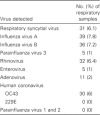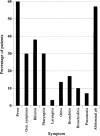An outbreak of coronavirus OC43 respiratory infection in Normandy, France
- PMID: 12684910
- PMCID: PMC7109673
- DOI: 10.1086/374222
An outbreak of coronavirus OC43 respiratory infection in Normandy, France
Abstract
The 2 groups of human coronaviruses (HCoVs) represented by the prototype strains HCoV 229E and HCoV OC43 are mostly known as viruses responsible for common cold syndrome. HCoVs are difficult to detect, and epidemiological data are rare. From October 2000 through April 2001, we tested 1803 respiratory samples for HCoV by reverse-transcriptase polymerase chain reaction. From 8 February through 27 March 2001, HCoV OC43 was detected in samples obtained from 30 (6%) of 501 patients. The other viruses detected were respiratory syncytial virus (6.1%), parainfluenza virus 3 (1%), influenza virus A (7.8%), influenza virus B (7.2%), rhinovirus (6.4%), enterovirus (1%), and adenovirus (2%). Infection with HCoV OC43 was detected in patients of all age groups. The following clinical symptoms were noted: fever (in 59.8% of patients), general symptoms (in 30%), digestive problems (in 56.8%), rhinitis (in 36.6%), pharyngitis (in 30%), laryngitis (in 3.3%), otitis (in 13.3%), bronchitis (in 16.6%), bronchiolitis (in 10%), and pneumonia (in 6.6%). This study shows that an outbreak of HCoV OC43 respiratory infection was responsible for the lower respiratory tract symptoms observed in nearly one-third of patients identified by active surveillance for coronavirus infection.
Figures



Similar articles
-
Coronavirus HKU1 and other coronavirus infections in Hong Kong.J Clin Microbiol. 2006 Jun;44(6):2063-71. doi: 10.1128/JCM.02614-05. J Clin Microbiol. 2006. PMID: 16757599 Free PMC article.
-
Genetic variability of human coronavirus OC43-, 229E-, and NL63-like strains and their association with lower respiratory tract infections of hospitalized infants and immunocompromised patients.J Med Virol. 2006 Jul;78(7):938-49. doi: 10.1002/jmv.20645. J Med Virol. 2006. PMID: 16721849 Free PMC article.
-
Coronavirus causes lower respiratory tract infections less frequently than RSV in hospitalized Norwegian children.Pediatr Infect Dis J. 2011 Apr;30(4):279-83. doi: 10.1097/INF.0b013e3181fcb159. Pediatr Infect Dis J. 2011. PMID: 21057374
-
[Coronaviruses as the cause of respiratory infections].Internist (Berl). 2019 Nov;60(11):1136-1145. doi: 10.1007/s00108-019-00671-5. Internist (Berl). 2019. PMID: 31455974 Free PMC article. Review. German.
-
Hosts and Sources of Endemic Human Coronaviruses.Adv Virus Res. 2018;100:163-188. doi: 10.1016/bs.aivir.2018.01.001. Epub 2018 Feb 16. Adv Virus Res. 2018. PMID: 29551135 Free PMC article. Review.
Cited by
-
Characterization of viral agents causing acute respiratory infection in a San Francisco University Medical Center Clinic during the influenza season.Clin Infect Dis. 2005 Sep 15;41(6):822-8. doi: 10.1086/432800. Epub 2005 Aug 4. Clin Infect Dis. 2005. PMID: 16107980 Free PMC article.
-
Detection of the new human coronavirus HKU1: a report of 6 cases.Clin Infect Dis. 2006 Mar 1;42(5):634-9. doi: 10.1086/500136. Epub 2006 Jan 24. Clin Infect Dis. 2006. PMID: 16447108 Free PMC article.
-
Development of three multiplex RT-PCR assays for the detection of 12 respiratory RNA viruses.J Virol Methods. 2005 Jun;126(1-2):53-63. doi: 10.1016/j.jviromet.2005.01.020. J Virol Methods. 2005. PMID: 15847919 Free PMC article.
-
Impact of rapid detection of viral and atypical bacterial pathogens by real-time polymerase chain reaction for patients with lower respiratory tract infection.Clin Infect Dis. 2005 Nov 15;41(10):1438-44. doi: 10.1086/497134. Epub 2005 Oct 13. Clin Infect Dis. 2005. PMID: 16231254 Free PMC article. Clinical Trial.
-
Comparative review of respiratory diseases caused by coronaviruses and influenza A viruses during epidemic season.Microbes Infect. 2020 Jul-Aug;22(6-7):236-244. doi: 10.1016/j.micinf.2020.05.005. Epub 2020 May 13. Microbes Infect. 2020. PMID: 32405236 Free PMC article. Review.
References
-
- Myint SH. Human coronaviruses: a brief review. Medical Virology. 1994;4:35–46.
MeSH terms
LinkOut - more resources
Full Text Sources
Other Literature Sources
Miscellaneous

